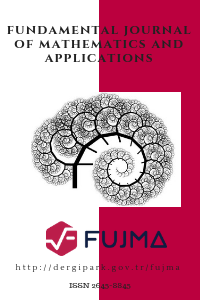On the Mean Flow Solutions of Related Rotating Disk Flows of the BEK System
On the Mean Flow Solutions of Related Rotating Disk Flows of the BEK System
Hydrodynamic Stability, BEK system flows Rotating flows,
___
- [1] W. E. Gray, The nature of the boundary layer flow at the nose of a swept wing, Roy. Aircraft Est. TM, 256 (1952).
- [2] D. Poll, Some observations of the transition process on the windward face of a long yawed cylinder, J. Fluid Mech., 150 (1985), 329–356.
- [3] P. Hall, An asymptotic investigation of the stationary modes of instability of the boundary layer on a rotating disc, Proc. R. Soc. Lond. Ser. A Math. Phys. Eng. Sci., 406 (1986).
- [4] R. J. Lingwood, Absolute instability of the ekman layer and related rotating flows, J. Fluid Mech., 331 (1997), 405–428.
- [5] P. Carpenter, The right sort of roughness, Nature, 388(6644) (1997), 713–714.
- [6] K. Choi, Fluid dynamics: The rough with the smooth, Nature, 440(7085) (2006), 754–754.
- [7] L. Sirovich, S. Karlsson, Turbulent drag reduction by passive mechanisms, Nature, 388(6644) (1997), 753–755.
- [8] B. Alveroglu, A. Segalini, S. J. Garrett, The effect of surface roughness on the convective instability of the BEK family of boundary-layer flows, Eur. J. Mech. B Fluids, 56 (2016), 178–187.
- [9] A. J. Colley, P. J. Thomas, P. W. Carpenter, A. J. Cooper, An experimental study of boundary-layer transition over a rotating, compliant disk, Phys. Fluids (1994-present), 11(11) (1999), 3340–3352.
- [10] S. J. Garrett, A. J. Cooper, J. H. Harris, M. Ozkan, A. Segalini, P. J. Thomas, On the stability of von karman rotating-disk boundary layers with radial anisotropic surface roughness, Phys. Fluids, 28(1) (2016), 014104.
- [11] M. Türkyılmazoğlu, Suspension of dust particles over a stretchable rotating disk and two-phase heat transfer. Int. J. Multiphase Flow, 127 (2020), 103260.
- [12] M. Türkyılmazoğlu, Single phase nanofluids in fluid mechanics and their hydrodynamic linear stability analysis, Comp. Meth. Prog. Biomedicine, 187 (2020), 105171.
- [13] T. Watanabe, H. M. Warui, N. Fujisawa, Effect of distributed roughness on laminar-turbulent transition in the boundary layer over a rotating cone, Experiments Fluids, 14(5) (1993), 390–392.
- [14] A. J. Cooper, J. H. Harris, S. J. Garrett, M. Ozkan, P. J. Thomas, The effect of anisotropic and isotropic roughness on the convective stability of the rotating disk boundary layer, Phys. Fluids, 27(1) (2015), 16.
- [15] A. J. Cooper, P. W. Carpenter, The stability of rotating-disc boundary-layer flow over a compliant wall. part 1. type I and II instabilities, J. Fluid Mech., 350 (1997), 231–259.
- [16] M. Miklavcic, C. Y. Wang, The flow due to a rough rotating disk, Z. Angew. Math. Phys., 55(2) (2004), 235–246.
- [17] M. S. Yoon, J. M. Hyun, P. Jun Sang, Flow and heat transfer over a rotating disk with surface roughness, Int. J. Heat Fluid Flow, 28(2) (2007), 262–267.
- ISSN: 2645-8845
- Yayın Aralığı: Yılda 4 Sayı
- Başlangıç: 2018
- Yayıncı: Fuat USTA
Covariant and Contravariant Symbols of Operators on $l^{2}(\mathbb{Z})$
On Solutions of a Higher Order Nonhomogeneous Ordinary Differential Equation
Elif NURAY YILDIRIM, Ali AKGUL
On the Logarithmic Summability of Sequences in Intuitionistic Fuzzy Normed Spaces
Fixed Point Formulation Using Exponential Logarithmic Transformations and Its Applications
Disjunctive Total Domination of Some Shadow Distance Graphs
On the Mean Flow Solutions of Related Rotating Disk Flows of the BEK System
Almost Para-Contact Metric Structures on 5-dimensional Nilpotent Lie Algebras
Nilüfer ÖZDEMİR, Mehmet SOLGUN, Şirin AKTAY
